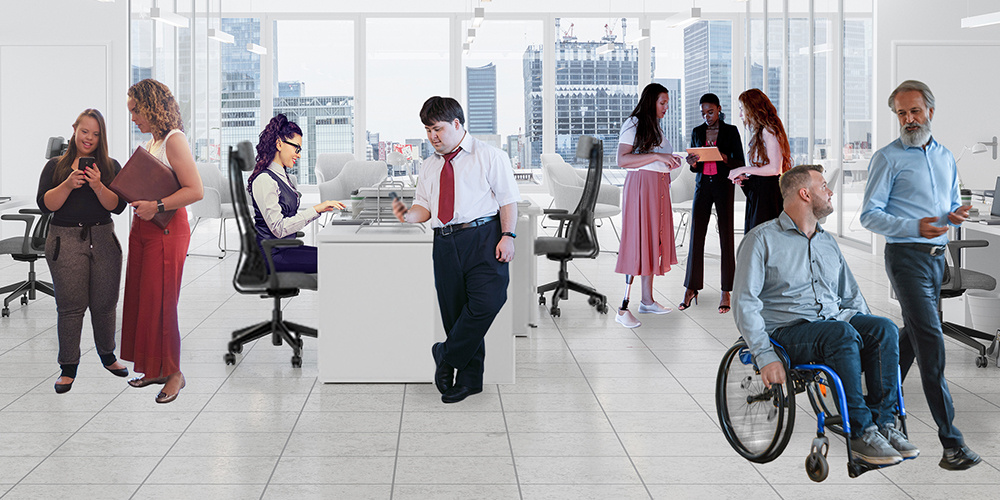This blog is written by Sumit Agarwal, a DEI advisor to Fortune 500 companies and one of LinkedIn's Top Voices. Born with cerebral palsy, Sumit has never let his disability impede his mission to inspire countless individuals living with the fear of being ostracized due to theirs. His journey is a testament to the power of resilience and the impact of fostering inclusive communities.
As someone who has spent years advocating for diversity, equity, and inclusion (DEI), I've come to realize that one of the most powerful tools we have at our disposal is often overlooked: behavioral design.
Today, I want to share with you why I believe behavioral design is crucial for creating truly inclusive environments and how we can harness its power to drive meaningful change.
First, let's discuss what behavioral design actually means. At its core, behavioral design is about understanding how people actually behave—not how we think they should behave—and creating environments that naturally lead to desired outcomes.
When it comes to DEI, this means moving beyond just telling people to "be more inclusive" and instead creating systems and structures that naturally lend themselves to fostering inclusion.
I've seen countless organizations implement DEI initiatives that rely heavily on training and awareness-raising. And while these efforts are well-intentioned, they often fall short of creating lasting change.
Why?
Because knowing about our biases doesn't automatically translate to changing deeply ingrained habits and systems.
This is where behavioral design comes in. Instead of relying on individual willpower or good intentions, we can redesign our processes and environments to create more inclusive outcomes naturally.
Let me give you a concrete example.
Many companies struggle with gender diversity in leadership positions.
Traditional approaches involve setting hiring targets or offering leadership training for women.
These can be helpful, but they don't address the root causes of the problem.
A behavioral design approach, on the other hand, might involve redesigning the entire promotion process.
This could include:
- Implementing standardized evaluation criteria to reduce the impact of subjective bias
- Using blind review processes for initial candidate screenings
- Ensuring diverse representation on promotion committees
- Creating structured sponsorship programs that pair high-potential women with senior leaders
These changes don't rely on individuals always making the "right" choice at the moment. Instead, they create processes that naturally lead to more equitable outcomes.
Another area where behavioral design can make a big difference is in creating inclusive meeting cultures.
We've all been in meetings where a few voices dominate while others struggle to be heard.
Simply telling people to "speak up more" or "listen better" rarely solves the problem. Instead, we can redesign how meetings are run. This might involve:
- Implementing a round-robin format where everyone gets a chance to speak
- Using anonymous idea submission tools to gather input from all participants
- Assigning roles like "devil's advocate" to ensure diverse perspectives are considered
- Setting clear agendas and time limits to prevent certain individuals from dominating the conversation
These structural changes can create more inclusive dynamics without relying on individuals to police their own behavior constantly.
Behavioral design can also be powerful in addressing microaggressions and creating more psychologically safe environments.
Instead of just telling people not to make insensitive comments, we can create systems that naturally reduce their occurrence and impact.
For example, we might:
- Implement a "no interruptions" rule in meetings, using a visual cue like a talking stick
- Create standardized templates for giving feedback to ensure it's specific and behavior-focused rather than personal
- Establish clear, accessible channels for reporting and addressing concerns
- Design physical spaces that encourage collaboration and equal participation
The beauty of these approaches is that they benefit more than just underrepresented groups—they often lead to better outcomes for everyone.
More structured meetings tend to be more productive. Clearer feedback helps all employees grow and improve. Collaborative spaces can boost creativity and innovation across the board.
Now, I want to address a common misconception: behavioral design isn't about manipulating people or taking away their agency. It's about creating environments where the easy choice is the inclusive choice. It's about removing barriers and creating opportunities for everyone to thrive.
It's also not a one-size-fits-all solution. Effective behavioral design requires a deep understanding of your specific context, culture, and challenges.
It involves ongoing experimentation, measurement, and refinement.
So, how can you start applying behavioral design principles to DEI in your organization? Here are a few steps:
1. Identify your pain points: Where are you seeing the biggest gaps in diversity, equity, or inclusion? Those are your opportunities for intervention.
2. Analyze the current process: Look closely at how things are currently done. What are the default options? Where are the decision points? Who has power and influence?
3. Reimagine the process: How could you redesign the system to create more inclusive outcomes naturally? What nudges or default options could you implement?
4. Test and iterate: Implement your changes on a small scale, measure the results, and refine your approach based on what you learn.
5. Scale and embed: Once you've found effective interventions, work to scale them across the organization and embed them into your standard processes.
Remember, the goal of behavioral design in DEI isn't to eliminate all bias or create perfect equity overnight.
It's to create environments where inclusion is the norm, not the exception, where diverse perspectives are naturally sought out and valued; and where everyone has the opportunity to bring their full, authentic selves to work.
As we continue to push for greater diversity, equity, and inclusion in our organizations and society, let's not underestimate the power of behavioral design.
By changing our systems and structures, we can create lasting change that goes beyond good intentions and transforms the way we work and interact.
It's time to move beyond just talking about inclusion and start designing for it.
Are you ready to reimagine your approach to DEI?

